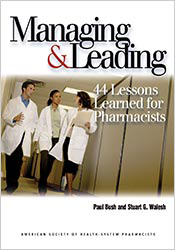Best Practices
- Improving Patient and Health System Outcomes through Advanced Pharmacy Practice: A Summary of evidence-based data (including the four focus points from the 2011 Report to the Surgeon General) that illustrate improved health care delivery with pharmacist involvement in patient-centered care
- Credentialing in Pharmacy: A Resource Paper: Provides an overview of education and credentialing activities and processes for pharmacists and pharmacy technicians. Additionally, it addresses issues to consider as the credentialing process continues to evolve.
- Design and Implementation of a Credentialing and Privileging model for Ambulatory Care Pharmacists: Provides a brief overview of credentialing and privileging. Also details Aurora Health Care model for credentialing pharmacists in specialty areas.
- The Consensus of the Pharmacy Practice Model Summit: Describes the consensus on the vision for pharmacy to ensure optimal medication-related care based on the education and training of pharmacists, enhancement of pharmacy technician capabilities, and the state of technology.
- Pharmacist Provider Status: An IHS Experience: This is a Power point presentation recalls the Social Security Act, describes the four focus points from the 2011 Report to the Surgeon General, compares credentialing and privileging, and discusses the New Mexico Pharmacist Clinician Certification.
- Shining a Spotlight on VA Clinical Pharmacy: A Power point presentation detailing the VA Advanced Pharmacy Services, education and committee structure, and quality outcomes.
- Pharmacists Prescribing: What Are the Next Steps?: Discusses improved access to medications with pharmacists, scope of practice, the value of pharmacist prescribers, international landscape, key issues, and future directions.
- Privileging Expands Pharmacists’ Role: Describes institutional privileging programs at The Johns Hopkins Hospital, Fort Belvoir Community Hospital, and St. Jude’s Research Hospital
- Prescribing Authority for Pharmacists: Describes collaborative drug therapy management for various disciplines, alludes to the Social Security Act not recognizing pharmacists as practitioners hindering eligibility for Medicare Part B payment, and advantages of pharmacist recognition as providers.
Credentialing and Re-Credentialing
- Credentialing and Privileging for Pharmacists: Provides a brief overview of credentialing and privileging. Also details Aurora Health Care model for credentialing pharmacists in specialty areas.
- Pharmacists Privileging in a Health System: Report of the Qualified Provider Model Ad Hoc Committee: Describes the rationale for credentialing and privileging and defines the steps involved in the processes.
- Board of Pharmacy Specialties Credentialing:Power point presentation describing the credentialing processes used by pharmacists, board certification process of pharmacy specialists, and current specialties approved by the Board of Pharmacy Specialties.
- Guiding Principles for Post-licensure Credentialing of Pharmacists: Provides leadership, guidance, public information, and coordination for the pharmacy profession’s credentialing programs.
Competencies
- Internal Approach to Competency-Based Credentialing for Hospital Clinical Pharmacists: Describes risk exposure, liability, prescribing authority, the certification and credentialing process, and advanced practice roles of pharmacists in the hospital setting.
Professional Development
- The Council on Credentialing in Pharmacy Resource Document Continuing Professional Development in Pharmacy: Discusses information about continuing professional development, provides definitions, describes drivers for enhancements for continuing education, and includes two case studies.
- Desired Professional Development Pathways for Clinical Pharmacists: Summarizes recommendations for postgraduate education and training for graduates. Also describes the preferred pathways for achieving, demonstrating, and maintaining competence as clinical pharmacists.
- Continuing Professional Development in Pharmacy: Defines continuing professional development, principles, application in health systems, and future directions.


